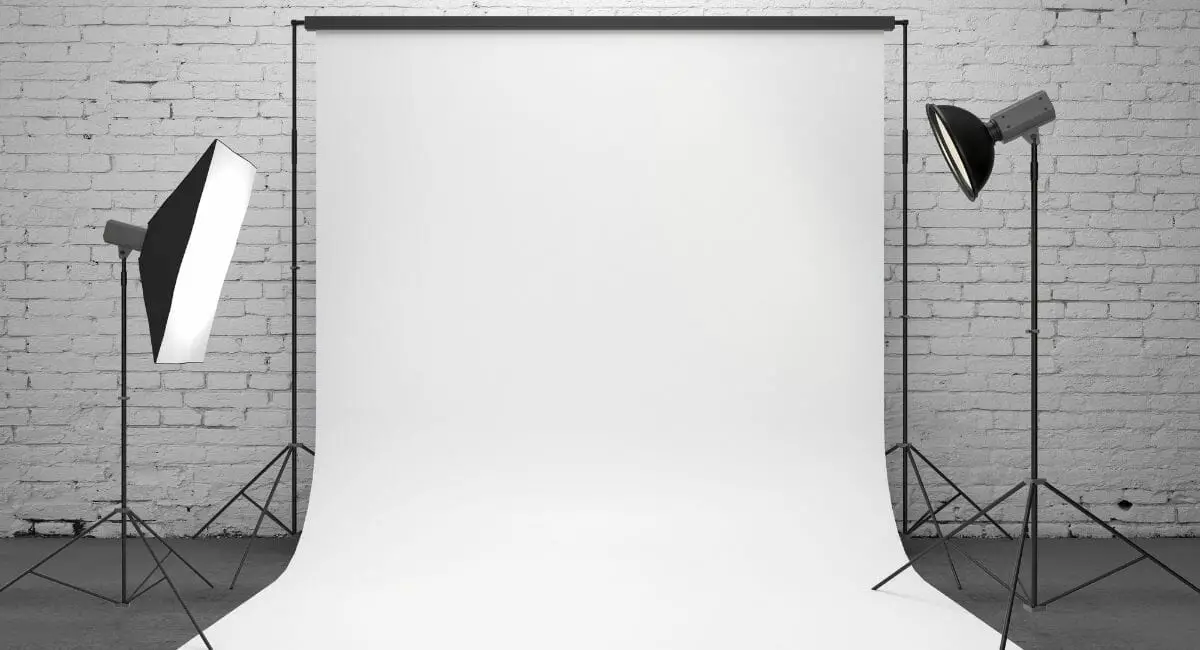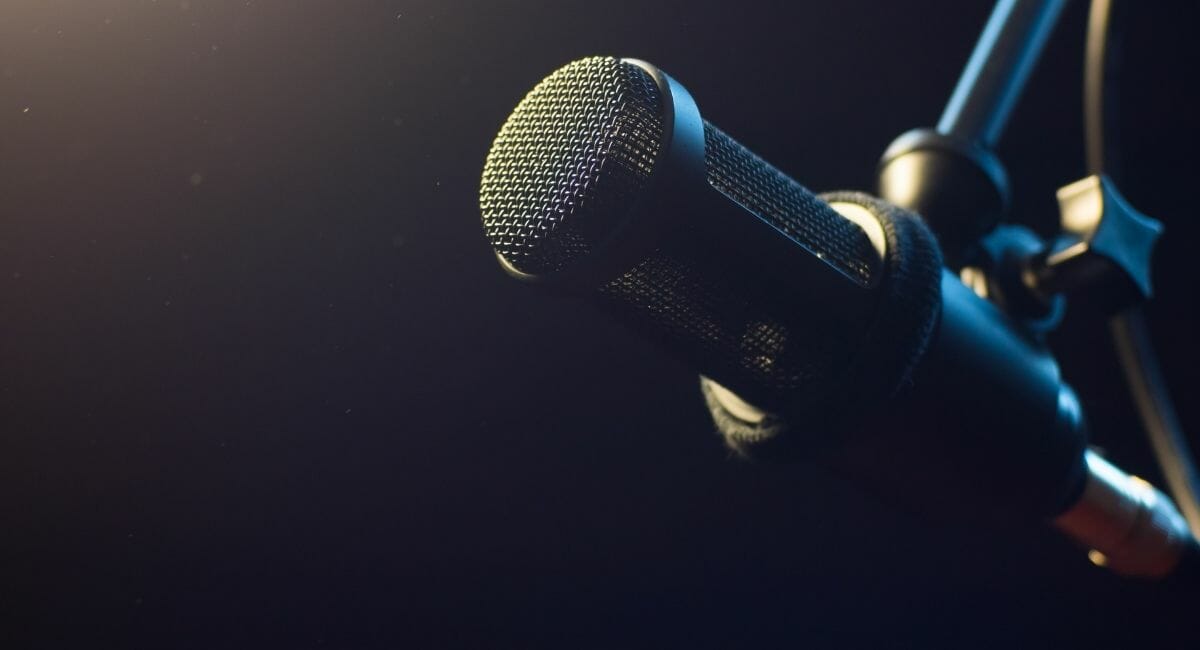If one of your 2021 resolutions is to produce audio with better quality, you’ll need to get your hands on the best studio monitors.
That means you’ll have to put your current speakers on a high shelf, but should you do that?
The short answer is yes!
At A Glance: Our Top 5 Picks For Budget Studio Monitors
- Best Overall: Mackie CR-X Series
- Runner Up: Edifier R1700BTs
- BEST MONITORS UNDER 100: Edifier R1280T
- Runner Up: Mackie CR-X Series
- Alternative: M-Audio BX3
How are studio monitors better than speakers? They create much more accurate sound as well as richer details.
That said, don’t think that your studio monitors need to be expensive. You can find budget-friendly options that will get the job done and provide you with excellent features to enhance your audio production.
With that in mind, let’s check out five of the best cheap studio monitors that you can purchase online.
The Studio Genie is dedicated to helping streamers and YouTubers or anyone looking to have their own home studio. The author, Felicity Martinez, have been helping out streamers and YouTubers for years.
The goal is to provide a free resource for anyone looking to build a quality home studio. The reviews below are a result of hours of research and analysis. We provided the pros and cons and ranked each product to help you make a quick decision.
QUICK OVERVIEW: Our Top Picks for Studio Monitors
| IMAGE | PRODUCT | |
|---|---|---|
BEST OVERALL  | Mackie CR-X Series 5-Inches
| VIEW ON AMAZON → |
RUNNER UP  | Edifier R1700BTs
| VIEW ON AMAZON → |
BEST MONITORS UNDER 100  | Edifier R1280T
| VIEW ON AMAZON → |
RUNNER UP  | Mackie CR-X Series 3-Inches
| VIEW ON AMAZON → |
ALTERNATIVE  | M-Audio BX3
| VIEW ON AMAZON → |
Best Budget Studio Monitors Reviews & Recommendations For 2021
Best studio monitors under 200, WINNER: Mackie CR-X Series 5-Inch Multimedia Monitors
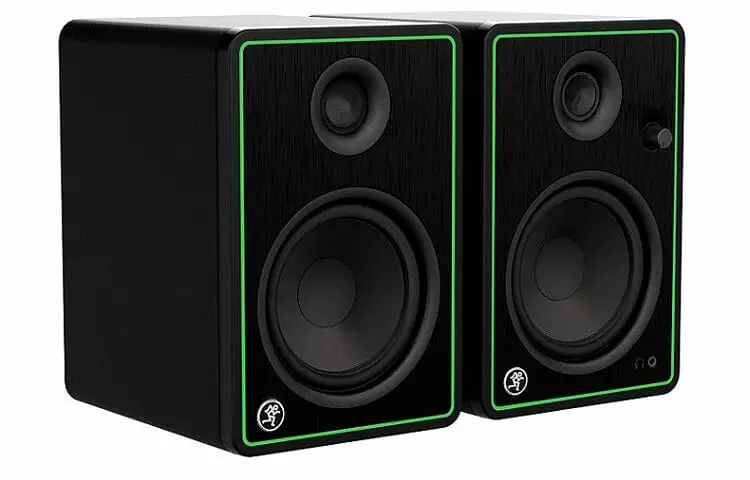
We start our list of the best studio monitors on a budget with these stylish Mackie monitors. Let’s check them out in more detail.
Benefits
- These monitors come with various inputs: a 2×1/4-inch jack, 1/8-inch standard headphone-size jack, and RCA.
- They come with front-panel controls so you can easily adjust the volume or switch on the monitor without a hassle.
- Setting up these monitors is a breeze, so even if you’ve never done it before you will not encounter any issues. This makes them beginner-friendly.
- These monitors offer you a lot of variety. You don’t have to switch inputs when you want to do different things. For example, you can play music while singing on a mic and doing other things, all at the same time.
- These monitors have custom-tuned rear ports for even bass.
- Their all-wood cabinet design is better than plastic alternatives because of how it produces natural sound.
Drawbacks
- Some people who have purchased this monitor have reported that they can sometimes hear a slight hissing sound.
Extra Features
- These monitors come with isolation pads.
- There’s also a convenient headphone output that’s built into the front panel.
- These monitors have a beautiful brushed metal front panel that is sure to look good on your desk.
Buying Advice
If you’re looking for a classy, stylish, and professional home audio recording setup, these budget studio monitors are your best bet. They cost $199.99.
Technical specifications
- Size: 6.9 x 10.25 x 9.25 inches
- Weight: 14.9 pounds
- Material: Textured wood cabinet and brushed metal faceplate
Runner Up: Edifier R1700BTs Active Wireless Studio Monitor Speaker
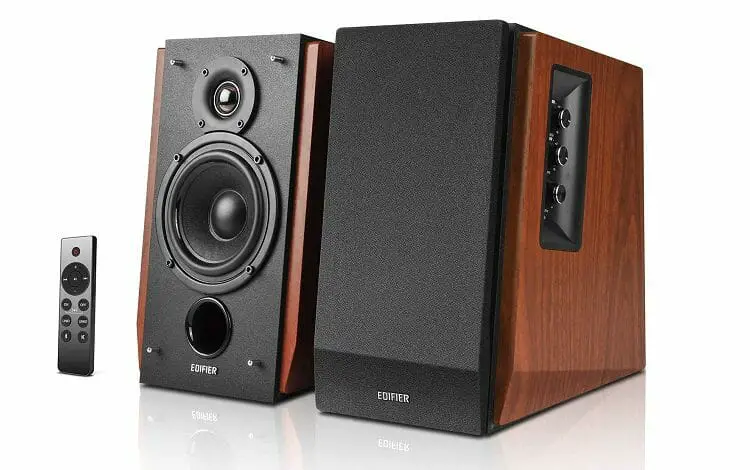
Edifier is a brand that’s well-established all over the world. Their monitors provide a clean sound that’s more refined. If you’re a beginner, these monitors will make you feel like a pro.
Benefits
- User-friendliness is the name of the game with these best budget home studio monitors. You can easily connect them to your laptop, tablet, or phone for wireless listening.
- They come with a subwoofer output that has built-in crossover and auto detection.
- The sound from these monitors is pure and natural, thanks to their 19mm silk dome tweeter and 4-inch woofer unit. You’ll be able to enjoy 66 watts of noise-free sound.
- You can do many tasks completely wirelessly on these monitors, such as controlling the volume, thanks to their updated wireless remote that’s included in the pack.
- These monitors also come with an RCA to RCA audio cable, a speaker connecting cable, and a 3.5mm RCA audio cable.
Drawbacks
- Some people have reported that they experienced a Bluetooth pairing issue with these monitors, such as in the form of a half-second lag between audio and video.
Extra Features
- This monitor not only produces amazing sound, but it also looks really good, thanks to its quality MDF wood and walnut-wood finish vinyl.
Buying Advice
These studio monitors look and sound professional, but they don’t cost a lot of money. You can expect to pay $159.99 for them.
Technical specifications
- Size: 17.01 x 12.05 x 7.56 inches
- Weight: 15.86 pounds
- Material: MDF wood with walnut wood finish-vinyl
Best studio monitors under 100, WINNER: Edifier R1280T Studio Monitor Speaker
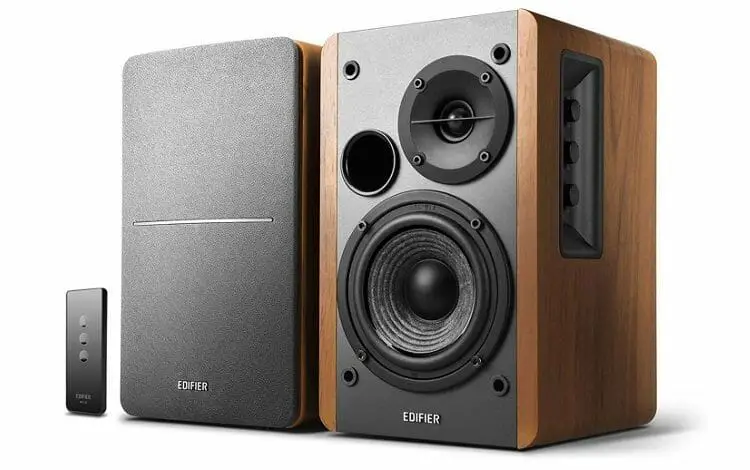
If you need to purchase monitors that are a bit friendlier to your budget, Edifier comes to the rescue again. They’ve offered a more cost-effective solution that doesn’t skimp on quality.
Benefits
- These monitors make it easy for you to connect them to any device, as long as it has a 3.5mm headphone output or dual RCA output. As a nice bonus, you can connect two devices via AUX.
- These monitors have 13mm silk dome tweeters to create a natural, professional sound.
- They also come with a remote (just like the previous Edifier product), so you can make changes to the sound you’re producing with ease, such as by adjusting volume from anywhere in the room.
- For greater ease of use, these monitors have a bass and treble control that’s found on the side of the main speaker.
- With their quality MDF wood construction, these bookshelf monitors provide a stylish design that will look good in any studio.
- These monitors don’t come with an input switch, which means that you can play sounds from different sources simultaneously.
Drawbacks
- These monitors don’t come enabled with Bluetooth.
- Some people who have purchased these monitors have reported that they sound a bit too low.
Extra Features
- Other people reported that they received these goods in excellent condition, with the cables, pre-split cables, wood finish, and packaging being of a high quality.
Buying Advice
These monitors sound and look like much more expensive ones, but they only cost $99.99. They’re a value-for-money option that will increase the quality of your sound.
Technical specifications
- Size: 6.9 x 9.5 x 5.8 inches
- Weight: 10.8 pounds
- Material: MDF wood build finished with wood effect vinyl
Runner Up: Mackie CR-X Series 3-Inch Multimedia Monitors
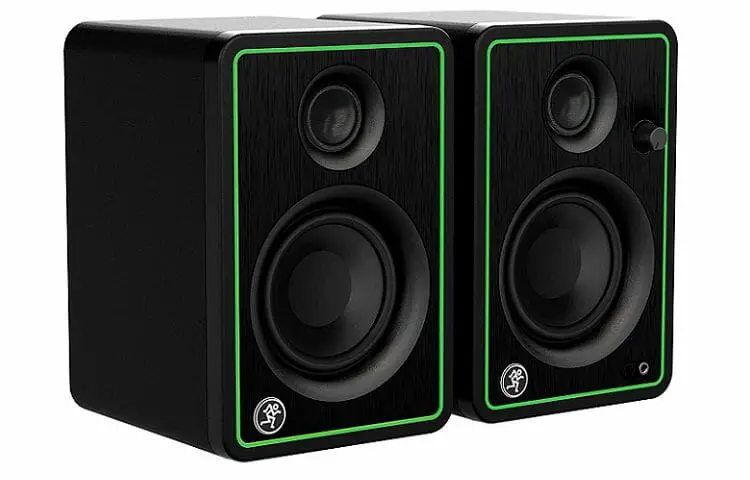
If you had your heart set on the Mackie CR5-X that we featured earlier in this list of best low budget studio monitors but it was still a bit too costly for you, you’ll love that you can purchase the Mackie CR3-X and still get a high-quality monitor without blowing your budget. Let’s check it out.
Benefits
- These CR3-X monitors have a stylish design with a brushed-metal panel that looks good in any room and with any decor.
- They come with a user-friendly front-panel headphone volume control and flexible rear-panel inputs. They provide ¼-inch TRS, 1/8-inch stereo, and RCA.
- Quality cables are included with your purchase of these best home studio monitors so you can start using them straight out of the box.
- The subwoofer is Bluetooth-enabled.
Drawbacks
- Some people who purchased these good budget studio monitors reported that they made a hissing noise when playing sounds at a low volume.
- Others have said that they produce too much bass.
Extra Features
- Even though these speakers are small, people who have bought them have said that they provide excellent range.
Buying Advice
So, what are you waiting for? If you need budget-friendly speakers in your home studio, these are definitely ones to purchase. They cost $99.99.
Technical specifications
- Size: 5.5 x 8.1 x 7.1 inches
- Weight: 7.8 pounds
- Material: Textured wood cabinet and brushed metal faceplate
Alternative. M-Audio BX3 - 120-Watt Powered Desktop Computer Speakers Studio Monitors
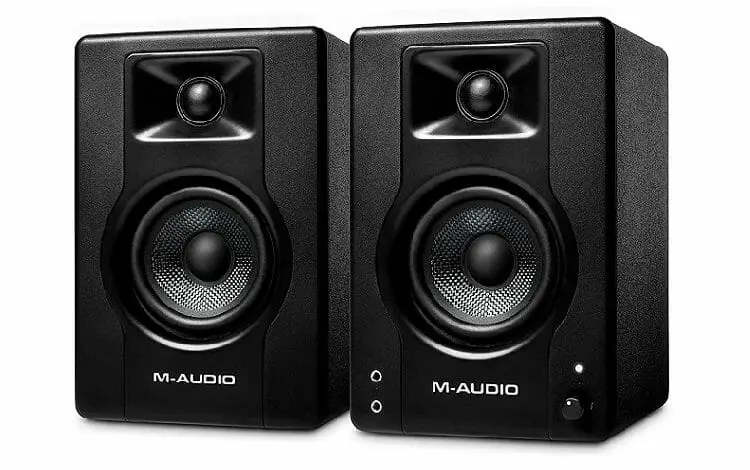
Maybe you’re not 100-percent sold on any of the monitors we’ve already featured in this list. Don’t worry – this alternative product ticks all the right boxes.
Benefits
- These speakers offer 120 watts of clean, studio-speaker sound. They can therefore be used for a variety of purposes, such as podcasting and streaming.
- These speakers have an acoustically-inert MDF cabinet and bass reflex design. The result? Rich, soulful sounds.
- They come with high and low EQ to ensure you get the best sound you’re hoping to achieve.
- They offer BX3’s, ¼-inch, 1/8-inch, and RCA inputs for greater versatility when it comes to your hookups.
Drawbacks
- Some people have reported problems with the cables that are included with the monitors. For example, the RCA cable is said to create static.
- These monitors aren’t Bluetooth-enabled.
Extra Features
- The low-frequency Kevlar drivers give your sound much more power.
- The monitors come with foam feet included. These are useful to prevent vibrations underneath the monitors when they’re placed on your desk.
Buying Advice
These best affordable studio monitors cost $99.99. While they might not give you everything you want for a professional sound-recording setup, for the price they are solid monitors that will improve the quality of your audio.
Technical specifications
- Size: 8.19 x 5.51 x 5.71 inches
- Weight: 10.93 pounds
- Material: Acoustically-inert MDF cabinet
Budget Studio Monitors FAQ
Perhaps after reading our reviews of the best budget studio monitors, you still have some questions about monitors and if they’re really necessary for your home studio.
With that in mind, let’s check out some of the most common studio monitor questions.
What is the difference between studio monitors and speakers?
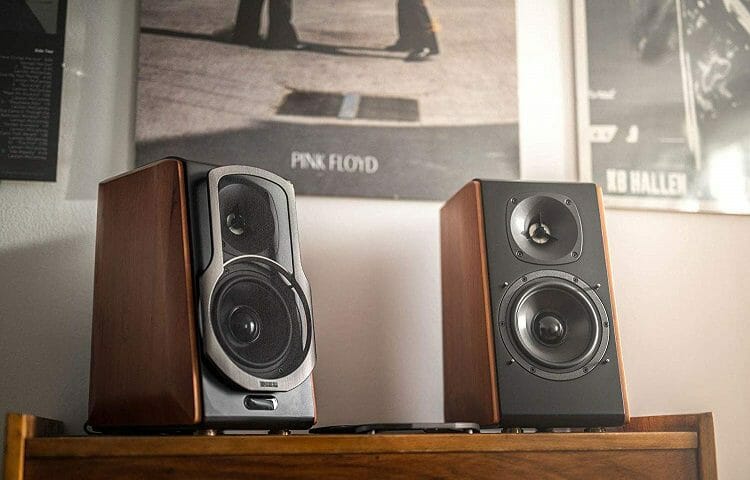
Earlier, we mentioned that monitors provide precise and detailed sound, but there are some other differences between monitors and speakers that you should know about.
Sometimes, speakers play back your audio recording in a pleasing way that colors the sound so that it can achieve a different personality. By comparison, studio monitors don’t do this. They are focused on providing a clear, natural sound that doesn’t have any additional tones. This is one of the reasons why they produce a much more accurate result.
When you use a powered speaker, it will project your sound well. Studio monitors, on the other hand, are more about providing excellent sound in smaller spaces.
In fact, the smaller the room in which you use them, the better – this ensures that your sound won’t have its frequency reduced or enhanced. This also means that your monitors won’t lose their accurate sound because they’re not trying to project the sound too much.
Based on the above, speakers are great for home entertainment purposes while monitors work effectively when you’re producing professional sounds.
Should I get studio monitors or headphones?
You might wonder if you can just get away with a great pair of headphones instead of purchasing monitors for your home studio. Here’s the lowdown.
While you can achieve good results with the use of headphones, this gear lacks a lot of depth. The result is that you get sounds which are very loud.
When you use monitors instead, you can produce a much more rounded and accurate sound. The thing to know about monitors vs headphones, however, is that monitors are quite demanding because they require an environment that’s got great acoustics.
It’s also worth mentioning that headphones have their benefits! Since your ears are supplied with the same audio stream at the same time, this gives you a sound that appears to be originating from right inside your head – it’s much more immersive. Not having room acoustics means that the audio elements are also brighter.
That said, for the longer term, using monitors helps you to gauge the true quality of your sound. Remember, on headphones your sounds will usually be pronounced, such as when it comes to reverb, delay, and panning in mixing sounds. It’s therefore a good idea to have both headphones and monitors.
Do I need 1 or 2 studio monitors?
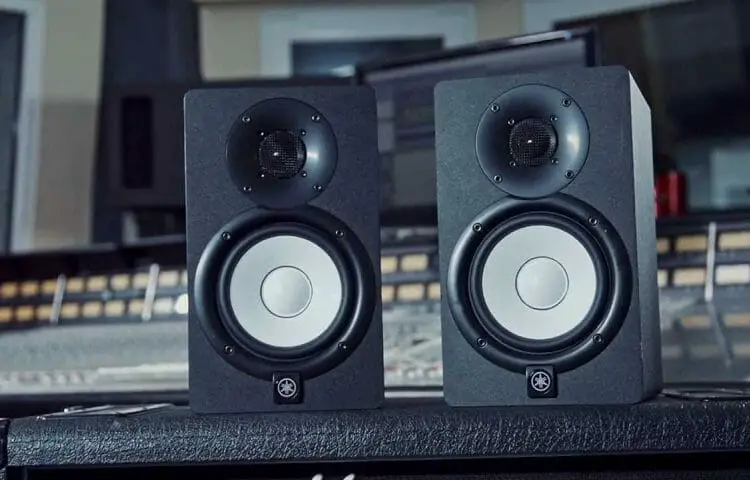
If you’ve decided to go ahead and purchase studio monitors, you might wonder if you need to have one or two. Generally, studio monitors will be sold individually, however you can find some great deals that include two in a pack, such as the Mackie CR5-X that we featured in our buying guide.
The amount of studio monitors that you need will mainly depend on what you’re going to be recording. If you are keen on producing music in your home studio, for example, you will need two monitors so that you can achieve stereo sound. This will give you a much better result when it comes to the quality of your recordings.
If you’re listening to music casually and that’s the main reason why you want to purchase a monitor (or two), you’ll be able to get by with just one of them.
Can I use studio monitors for gaming?
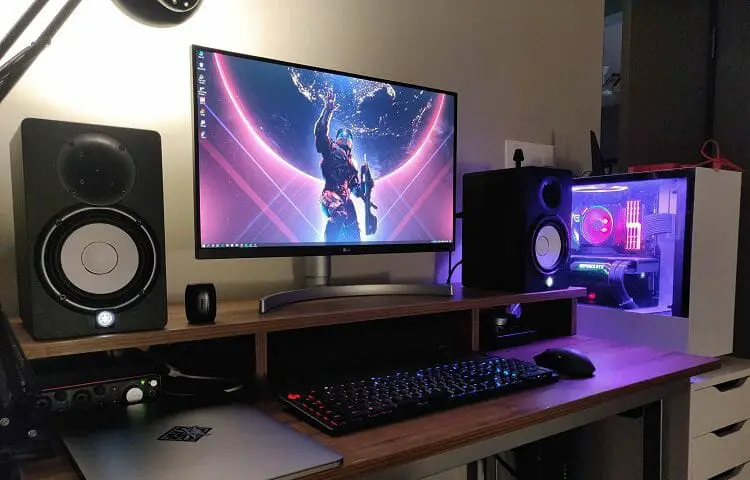
Earlier, we talked about how speakers can be great for home entertainment purposes. But what about playing games? Can you use studio monitors for this activity, and is it a good idea?
It is, because studio monitors can be used in the same way as you’d use speakers. You can use them for everyday use, but it’s important to remember that you need to place the monitors in a small area as they will perform better – they don’t project sound in the way that speakers are designed to do.
When you choose studio monitors with which to play games, take care with the type of monitors that are out there.
There are some that will really enhance your gaming experience and make you feel like you’re part of it – really, what gamer doesn’t want to achieve that? To get that, however, you need to ensure that your monitors meet all the important criteria you need in order to enjoy them when playing your favorite games. Here are some to consider.
The monitor needs to produce a good amount of bass. You want to be able to enjoy high and mid-range sounds as these will make you feel more immersed in the game.
The monitor should be compatible with a variety of devices. This will make it much more versatile and user-friendly.
The monitor should also look the part. You want it to be compact, sturdy, and durable so that it won’t let you down after those day-long gaming sessions. A compact studio monitor is important so that it doesn’t take up too much space in your gaming area.
Ideally, a monitor should also come with anti-vibration features, such as foam feet to make it even sturdier. You can find these feet in the M-Audio BX3 monitor that we featured in our buying guide.
Should you mix on headphones or studio monitors?
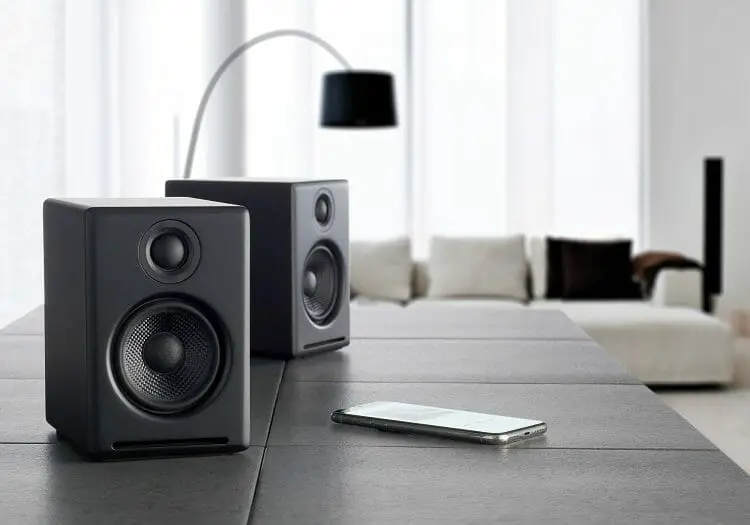
Some people have had success with mixing solely on headphones, provided that they are of a good quality.
Headphones can be used to draw out all the details in your sound that sometimes become lost in speakers. This ensures that you pick up on things to edit in your sound production, which contributes to a higher level of quality by the time you’re done.
Headphones are also useful when it comes to mixing if you don’t have a good monitor setup in your home studio. For example, if your monitors are of a low quality or your studio doesn’t have the right acoustics. In such cases, headphones can help you to mix sound in a much easier way and still get good results.
That said, headphones sometimes have some drawbacks when it comes to mixing. Different headphones will have different frequency responses that can change your final product.
One of the best things about studio monitors when it comes to mixing is that they provide an accurate sound that isn’t colored by anything. So, when choosing headphones, make sure you buy ones that provide a neutral, natural approach as much as possible.
Before you go out in search of the best headphones, it’s worth pointing out that studio monitors can make your final sound much more professional.
For starters, when you’re not feeling like the sound is coming from your head, as in the case of using headphones, this will give you a better idea of what your listeners will experience.
Monitors are also known for making your mixing work much quicker and easier. This is because mixing translates better from monitors to headphones instead of from headphones to monitors. When you mix from headphones to monitors, this results in a lot more sound editing, which can make your workload heavier and probably more stressful.
For example, because headphones remove room acoustics from your experience, you will get a more manufactured or even sterile sound that doesn’t sound as vibrant to listeners, resulting in you having to return to the mix and provide extra elements to bolster the sound experience.
Things to Consider Before Buying a Studio Monitor
Here are a few things to consider before buying a studio monitor.
Sizes and Positioning
When looking for the best monitor speakers, size and placement are important factors to consider. You won’t be able to fit huge monitors into a tiny recording studio. If you have a specialized recording room, on the other hand, you might prefer a large pair.
The accuracy of your studio monitors might change depending on the size of the room. You can’t mix the music if your monitors are too big or too small.
You may want to consider where you intend to place your studio monitors. Studio monitors should be placed in a way that forms an equilateral triangle with you, as this provides the best stereo sound for editing and mixing your recordings.
Power
Studio monitors with the proper power and signal will be more accurate. You’ll need constant power to get the best sound. Not only can the amount of power influence the volume, but it may also impact the dynamic range.
Some of the best studio monitors have high wattage. You can hear more details in your recordings with more power. You’ll also have the best headroom for peaks in loud music, such as a kick drum.
Materials
Studio monitors are made of a range of materials, including metal and paper. The materials might influence the sound quality you experience. When comparing prices, you should also examine the materials and their quality. A costly set of monitors made of low-quality materials isn’t worth it.
Passive vs Active Studio
Think about whether you want passive or active studio monitors. Both options have advantages and disadvantages, so weigh them carefully. You’ll need an amplifier in addition to the monitors if you go with a passive setup. Passive systems have a long history in the recording business and are an excellent choice.
However, if you have a small studio, the extra gear might be a turn-off.
In that situation, an active system is a viable option. Studio monitors with an amplifier are known as active studio monitors. You won’t have to bother about connecting your monitors to an amp or setting it up.
When you don’t want to deal with a lot of equipment, that can be useful. An active system should serve you well if you’re new to recording. These systems are simpler to set up and operate, and they don’t take up much room.
A passive system, on the other hand, gives you more control over the amplifier. You can then choose the appropriate amplifier for your studio monitors.
Specifications
Studio speakers, like other pieces of equipment, will have specs that describe their performance and quality. Even so, you don’t have to take into account every detail in the spec sheet.
Here are some of the most crucial features to look for when purchasing studio monitoring speakers:
- Frequency Response: This refers to the device’s dynamic range of tones.
- Sensitivity: The speaker’s ability to convert power into high-quality, loud sound.
- Impedance: The amount of electrical resistance a device offers to an amplifier.
Power Handling: The suggested strength of the connected amplifier.
Conclusion
If you want to upgrade your audio recordings, you’ll need to purchase monitors.
These deliver crisp, detailed sound that will make your recordings so much more professional – and help you achieve your creative goals for 2021.
In this buying guide, we’ve featured five of the best studio monitors that don’t cost a lot of money and offer seamless audio production no matter where you are.
Did you like the article? Please rate it:


